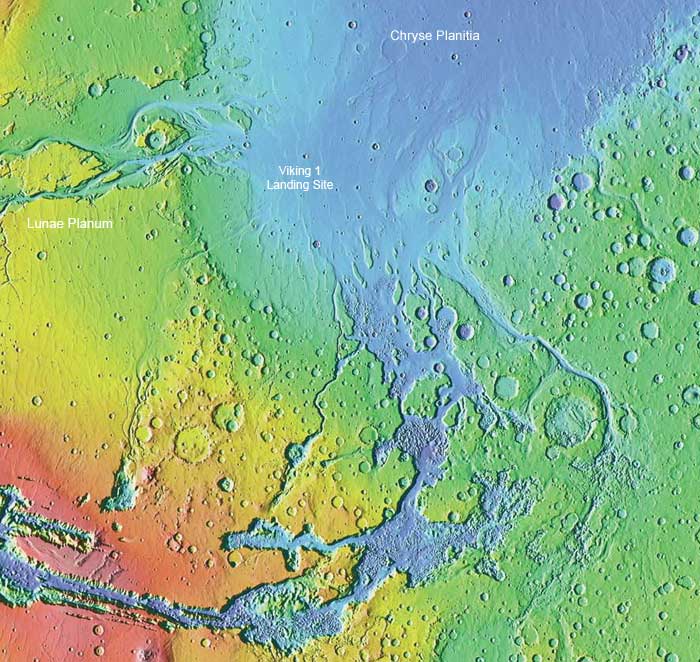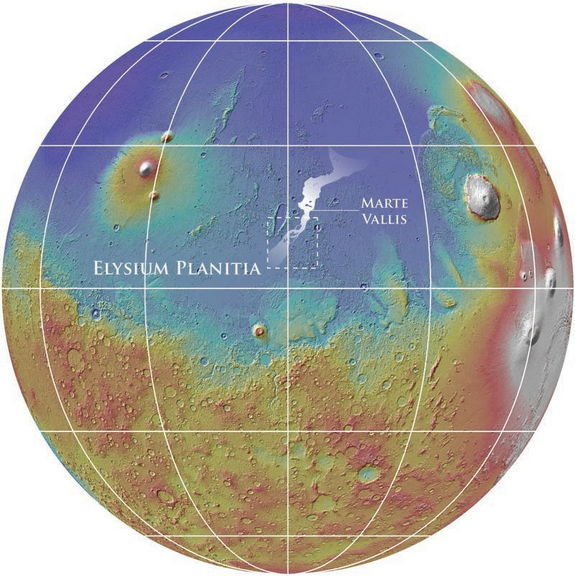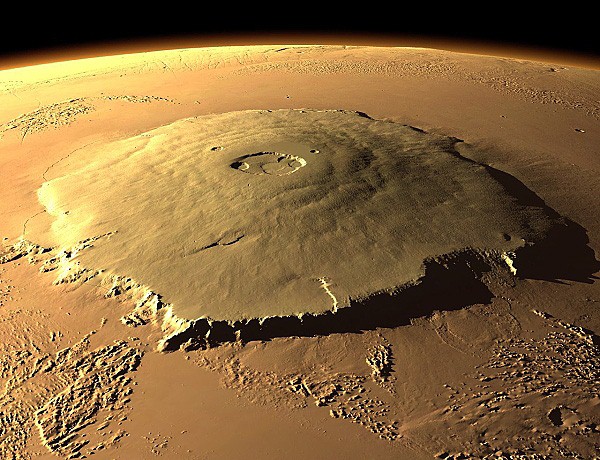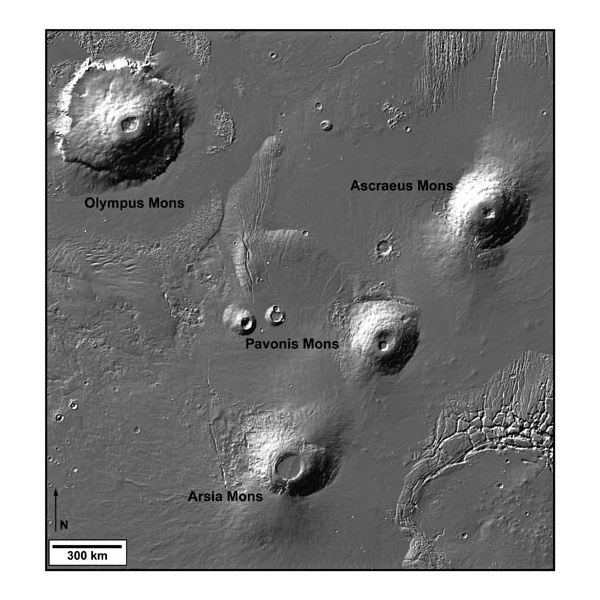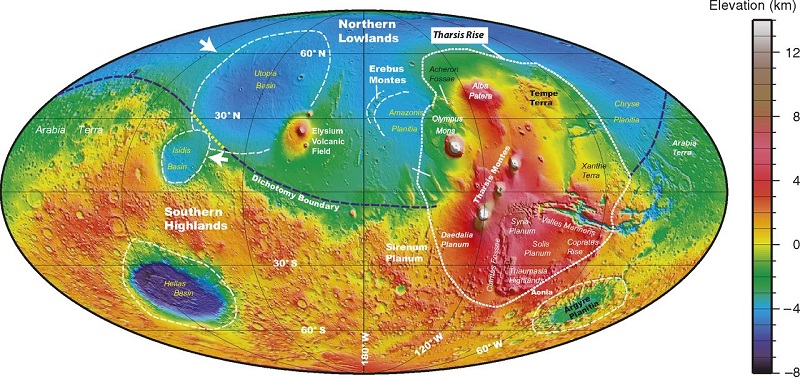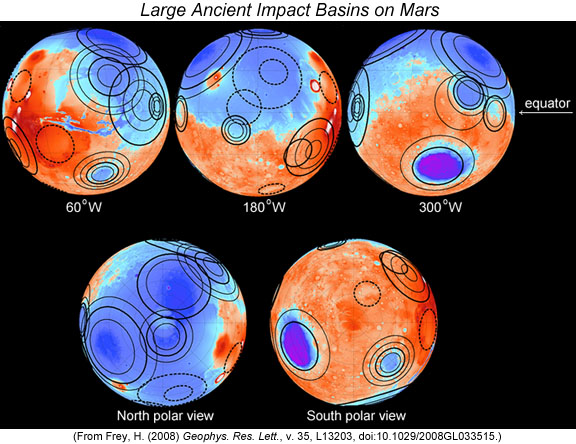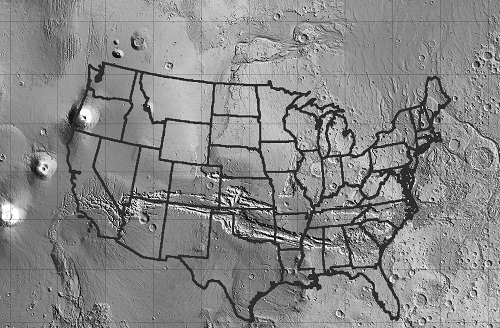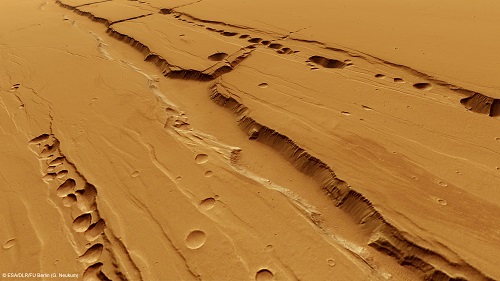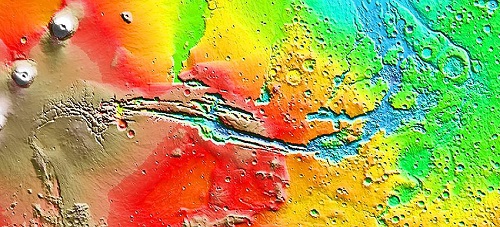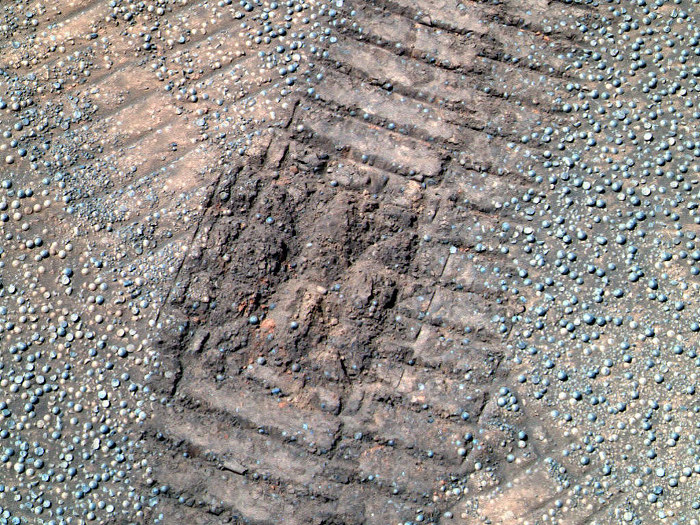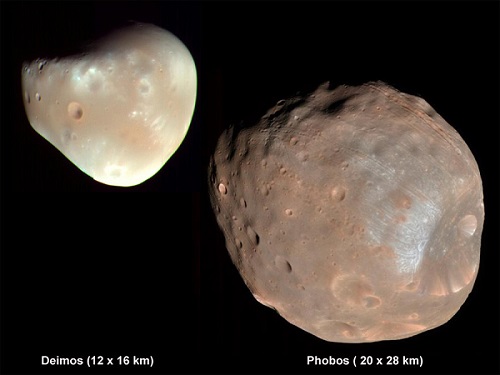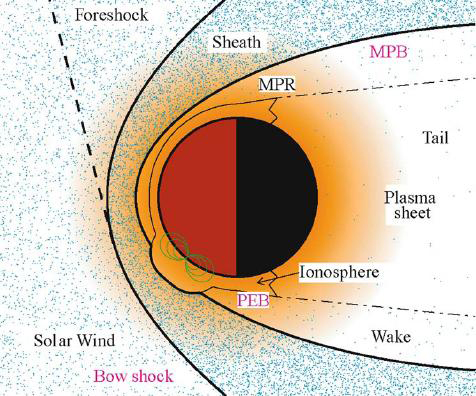Mars
Mars, the red planet -- the other one about which so much has been guessed and so many science fiction stories have been written. But there are no Martians on Mars; no little green men. Nevertheless, Mars is a fascinating planet and our probes are still sending us back pictures.
Mars is only about half the size of Earth (it is the second smallest planet in our solar system), with a diameter of 4250 miles. This means its gravity is also less than half of Earth's -- it is 0.4 Earth's gravity. However, its axis tilt is about the same. Earth's is 23.5 degrees, and Mars' is 25 degrees.
Mars is 1.52 AU from the sun, and so its year is longer than any of the other inner planets, lasting 687 Earth days. It's day is about the same length as ours, though, at about 24.5 hours. So it spins on its axis at almost the same rate Earth does even though it is much smaller and farther from the sun. Because its days are close to the same, its temperatures, while colder than Earth's due its distance from the sun, are still within a range we can understand. Temperatures there range from a high of about 70 degrees F. to a low of about -220 degrees F. Since Mars has an axis tilt about the same as ours, it also has seasons. There are ice caps on the poles that melt back when each pole is at its 'summer,' and facing the sun. The ice caps are made of layers of water ice and carbon dioxide ice. When astronomerrs first saw the ice caps and how they melted seasonally, they were quite sure there were waters flowing through channels away from the poles. What they found later, however, was that the ice was simply vaporizing, and not becoming liquid. This transition from a solid state directly to a gas state is called subliimation. We see it happen with 'dry ice' which is carbon dioxide ice. Atmosphere Mars' atmosphere is less than 1% as dense as Earth's. It is made up of 95.3% carbon dioxide, 2.7% nitrogen, and 2% other gases, including argon and water vapor. We do see occasional clouds on Mars, and our probes have told us they are made up of water ice crystals. We have also seen massive dust storms. These yellow/orange storms are huge and can sometimes cover almost the whole planet. There are also phenomena which have been dubbed "rocket dust storms" in which "blobs" of dust shoot upward very rapidly, as the article and video Crazy Alien Weather: Lightning-Filled Rocket Dust Storms of Mars explains.
Surface Features THE POLAR CAPS The terrain at the poles is different from elsewhere on the planet. The poles exhibit the youngest strata since they are the products of yearly deposition and erosion. Both the north and south ice caps are layered: dust, water ice, and carbon dioxide ice. In the winter, carbon dioxide freezes out of the atmosphere, producing a thin coating of carbon dioxide ice over the water ice. At the same time, however, the summer on the opposite hemisphere is producing the dust storms which coat the planet, and so there is a layer of dust being deposited during a pole's winter as well. Below left is a photograph of the dust-covered ice at the north pole. Below the ice caps are sand dunes, on the lower part of the picture. The great stretches of sand dunes which surround the north pole completely obscure everything beneath them. The picture on the right shows a side-on clear view of the layering.
The north polar cap is the largest and is primarily water ice. Both ice caps will show some melt-back and erosion effects during summer for each (when it is winter for one, it is summer for the other, just like on Earth). Interestingly, both polar caps have spiral appearances as seen from above.
THE NORTHERN LOWLANDS
The orange areas,such as Arabia Terra and the Amazonis Planitia are desert areas which are soil and sand covered. A NASA spokesman has stated, "If you look at the soil composition of Mars, the one thing that really strikes you is that it's 5 to 14 percent iron oxide," said Dr. Peter Curreri, a materials scientist at NASA's Marshall Space Flight Center. "It's almost ore-grade material." The following quote is from a NASA website that appears to be down:
The red desert areas are primarily the "northern plains." They are depressed areas, something like the maria on our moon. We can see drainage channels leading into them, indicating there was a lot of water there at some time in the past.
It is important to remember the colors are false and the blue is NOT water! Many craters can be seen in these areas. The water that, sometime in the past, drained into these low-lying areas came from the interior of the planet. They probably formed a northern ocean which was then evaporated by later lava extrusions.
from an article in Time, March 11, 2013:
VOLCANOES AND CANYONS Mars has the biggest volcano and the largest canyon system in the solar system. Olympus Mons
Just in case Olympus Mons looks like a little bump on Mars to you, please notice the curvature of the planet behind it... Olympus Mons is a shield volcano sixteen miles high (three times the height of Everest), and the base of the volcano is 370 miles across. The crater at the top is a collapsed caldera which is the size of Rhode Island -- about 45 miles across. There is a cluster of volcanoes to the east of Olympus Mons and they are all part of what is called the Tharsis Uplift.
The Tharsis Upllift (or Tharsis Rise) is dome-shaped bulge about 3.5 miles high and about 2000 miles across.
On the upper left of the above map of Mars is the Utopia Basin. On the lower right of that basin you will see the Elysium Volcanic Field. Elysium Mons is the major volcano in that area. This is part of another uplift -- large and dome-shaped, about 3 miles high and almost a thousand miles wide. The map above is not one side of Mars, it is pictured as though the planet itself were 'unwrapped' and put onto a flat sheet. There is something important to note when you remember that. On the lower left is the large Hellas Basin. It is a giant impact site, 1430 miles across and 5.6 miles deep. This impact's pressure wave went through the planet. If you remember the Caloris Basin on Mercury, you will remember that on the opposite side of that small planet, the shock wave of that impact resulted in the "weird terrain." A more violent reaction occurred on Mars due to the much stronger and larger impact. It was the Tharsis Uplift that resulted from this hit. When you 're-wrap' the map above, you will find that the Hellas Basin is exactly opposite the Tharsis Uplift. This happened at another point, too, which you can see above. On the lower right of the map there is a sort of green oval. This is the Argyre Planitia, or Basin. It is another impact site. It is 1120 miles across and 3.2 miles deep. Exactly opposite it is the Elysium Volcanic Field and its associated uplift. So we see on Mercury, Earth and Mars that violent impacts have caused shocks to go through the planets and have resulted in evidence on the opposite side of the planet. Going back to the map we have been discussing:
The northern plains which we know were flooded with water at an earlier date, were flooded because they were depressed areas. They were depressed due to a series of impacts, as shown below:
This major series of impacts was the result of something called the Late Heavy Bombardment which came in from the Kuiper Belt, long before the planet between Mars and Jupiter broke up. These hits produced the massive craters which later flooded with water when Asteroid Planet began breaking up, producing the Hellas and Argyre crater basins. After the flood, magma was outpoured from the interior, probably due to hits from the breakup of the asteroid planet. The magma outpoured into the lowland areas, and we can see where it covered the water drainage channels. The heat from the molten magma evaporated the water. However, that water acted with the iron oxide in the magma to form the red rust we associated with the color of Mars now. That combination would have also given rise to the massive amounts of carbon dioxide we find in the Martian atmosphere now. The series of hits which released so much magma were probably also those which gave rise to the Hellas Basin and the Argyre Basin. Mars was relatively close to that planet and would have received some significant impacts when it broke up. All of the craters in the south have come from the asteroid planet and moon breakup events. Just south of the Tharsis Uplift is the Valles Marineris, the largest canyon system in the entire solar system. As you can see from the illustration below, it would cross the entire United States, totally dwarfing our Grand Canyon. To the left you will see the three Tharsis volcanoes a little southeast of Olympus Mons.
A closer photograph gives us a little more detail of part of it:
The Valles Marineris measures about an average of 120 miles wide (up to 375 miles in places), 4 miles deep, and about 3100 miles long. We know it was a major drainage channel for the exploding waters, but it also shows distinct signs of electrical discharge activity. This can be seen in the scalloped sides and the lower line of pit chains next to it. The initial formation was most probably due to a giant split in the crust at the time of the Hellas Basin impact, which resulted in the Tharsis Uplift. Because this was associated with the breakup of the Asteroid Planet, electrical effects would also have been involved, which is why we see the evidence of the electrical discharges. These formations are more clearly explained in the article on crater formation. Evidence for both types of craters is found all over the planet. Below is a good photograph of the pit chains on Mars caused by electrical machining discharges (which are, basically, the result of lightning discharges which are attempting to equalize positive and negative charges during a disruption).
Research on this canyon system is indicating that it may be a very large transform fault, and one that shows indications of horizontal slippage. We highly recommend the short, and lay-friendly, article from physicsworld on this. However we strongly disagree with the last part of the article which indicates the long ages involved on Mars and the 'slow and gradual' processes involved.
The illustration above shows several things in excellent detail. First, however, remember that the colors were added -- blue is not water (it is lowlands), green is not pastures, etc. You can see the very, very straight line of the Valles Marineris which does give evidence of a separation of two crustal plates, as well as giving apparent evidence of slippage along that fault line. The smaller parallel canyon sections just to the north of the main canyon are also indicative of crustal plates breaking and slipping past each other. As the fault itself ends, there is evidence of previous lake formation and then the drainage of the entire area into the Northern Lowlands. The multitude of craters give evidence of both impacts and electrical machining. BLUEBERRIES Blueberries! Well, that's what they're called, anyway. Take a look:
Mars Rover tracks over a field of "blueberries" Blueberries are evidence of water in the past as NASA explains in an article on the web.
Mars' Moons Earth has one moon; Mars has two: Phobos and Deimos. They don't look like our moon at all, because whereas our moon was formed along with Earth, Mars' moons are simply captured big rocks. They are probably pieces from the Asteroid Planet moon which broke up. This is concluded because of their carbonaceous content. Phobos is closer to Mars (5800 miles) and orbits it quickly, once every 7.66 hours. Deimos is farther out (14,500 miles) and orbits more slowly, at 30.35 hours. As a quick comparison to our moon which orbits about every 29 days, it is 250,000 miles from the earth, so Mars' moons are very close to it in astronomical terms. Australia is over twice the distance from the United States as Phobos is from Mars.
Even these moons, as small as they are,have their own craters. On Phobos there is a crater large enough to be named, Stickney. You can see it more clearly in the photograph below.
The very dramatic hole in its side is not an impact crater. If this rock had been hit that hard by another object, it would have shattered. This is a hole made by electrical machining. Further evidence of this origin is in the striations along the side and the rows of pit chains along these striations, as well. (Impact striations radiate outward in all directions from the crater.) Mars, like Venus, has no magnetic north or south pole, but the reason is different. Venus has not got the magnetic poles because it rotates so slowly. Mars, however, used to have them, but they are gone now. The magnetic poles have two causes that work together: the spinning of the core of the planet and the amount of radioactive heating in its interior. Mars is the second smallest planet, and, in part due to its position in the planetary lineup, also has the smallest core. Since the heavy elements are concentrated in the cores of the planets, this means Mars also had the least amount of radioactive decay going on. But it was there. Now, consider something else: On the inside of Mars is Earth, which had the giant,world-wide flood when the waters outgased after the hits from the initial breakup of the Asteroid Planet. On the other side of Mars was the Asteroid Planet which did not survive its internal heating. Because Mars is little, it did survive its internal heating but the amount of material outgased in the form of both water and magma were enormous for its size. That outgasing, however, did relieve the heat and the pressure from the interior.This vastly reduced its magnetic field as the heat was carried away from the interior. There was no longer enough radioactive material left to heat the interior enough to produce a magnetic field, even though the core was still turning. Thus, when we see Mars' ionosphere, we do not see the polar cusps. They are gone now.
A Brief History of Mars
Update, April 8, 2015 -- Mars rover Curiosity spots 'ice cream sandwich' rocks September, 2015 -- Water on Mars? July, 2017 -- A Fictive Flight Above Real Mars
|



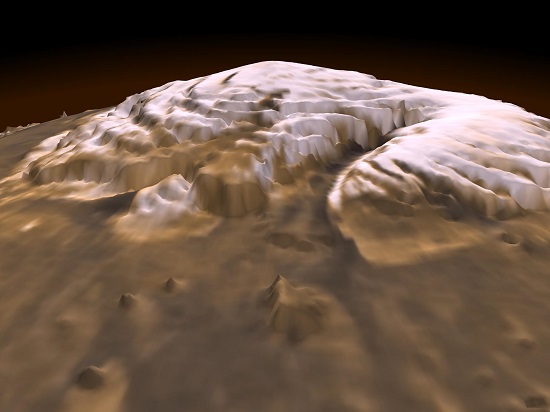
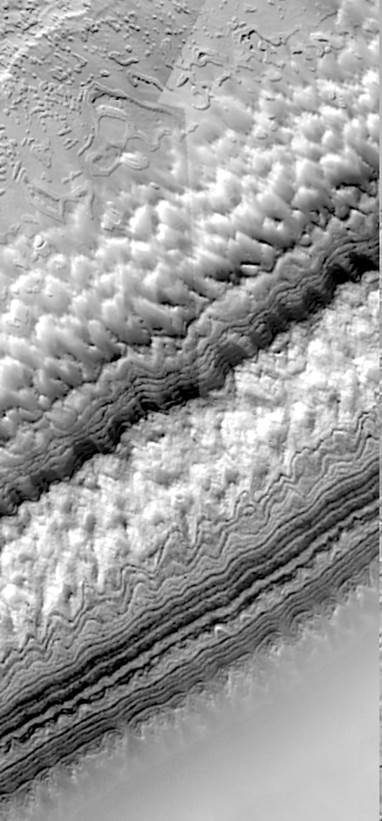
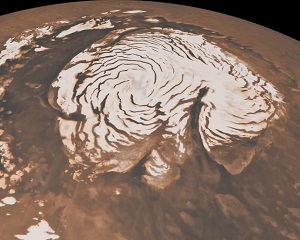
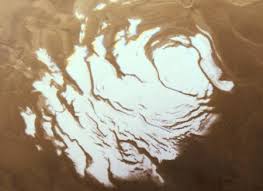
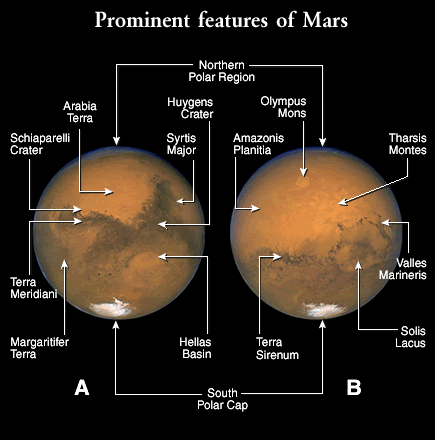 :
: 